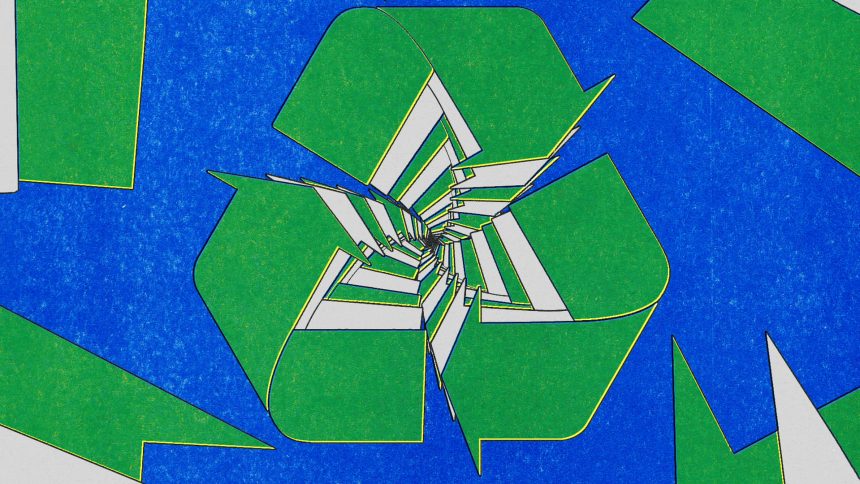It’s Earth Day 1990, and Meryl Streep walks into a bar. She’s distraught about the state of the environment. “It’s crazy what we’re doing. It’s very, very, very bad,” she says in ABC’s prime-time Earth Day special, letting out heavy sighs and listing jumbled statistics about deforestation and the hole in the ozone layer. The bartender, Kevin Costner, says he used to be scared, too — until he started doing something about it. “These?” he says, holding up a soda can. “I recycle these.” As Streep prepares to launch her beer can into the recycling bin, Costner cautions her, “This could change your life.”
Recycling, once considered the domain of people with “long hair, granny glasses, and tie-dyed Ts,” as the Chicago Tribune described it at the time, was about to go mainstream. The iconic chasing-arrows recycling symbol, invented 20 years earlier, was everywhere in the early 1990s. Its tight spiral of folded arrows seemed to promise that discarded glass bottles and yellowing newspapers had a bright future, where they could be reborn in a cycle that stretched to infinity.
As curbside pickup programs spread across the United States, the practice of sorting your trash would become, for many, as routine as brushing your teeth — an everyday habit that made you feel a little more responsible. What no one anticipated was just how emotionally attached people would become to recycling as the solution to America’s ugly trash problem.
When the chasing arrows’ promise of rebirth was broken, they could get angry. One cold winter day in 1991, people in Holyoke, Massachusetts, chased after garbage trucks, yelling for them to stop, after the drivers had nabbed their sorted glass, cans, and cardboard from the curb. Strained by an influx of holiday-related trash, the city had instructed workers to forgo recycling and just throw everything away.
Today, the recycling icon is omnipresent — found on plastic bottles, cereal boxes, and bins loitering alongside curbs across the country. The chasing arrows, though, are often plastered on products that aren’t recyclable at all, particularly products made of plastic, like dog chew toys and inflatable swim rings. Last year, the Environmental Protection Agency said that the symbol’s use on many plastic products was “deceptive.”
Recycling rules can be downright mystifying. For years, people were told pizza boxes were too greasy to be recycled, but now many recycling centers accept them. Some cities accept juice boxes lined with invisible layers of aluminum and plastic; others don’t. And do the screw-on caps stay on plastic bottles or not? Recycling experts ask people to do a “little bit of homework” to figure out what their local recycling system can handle, but since households have hundreds of items with different packaging to keep track of, that’s asking a lot.
The resulting confusion has made a mess of recycling efforts. Plastic wrap tangles around sorting equipment at recycling facilities, shutting down operations as employees try to cut it out of the equipment. Huge bales of paper shipped overseas can contain as much as 30 percent plastic waste.
“Contamination is one of the biggest challenges facing the recycling industry,” the EPA said in a statement to Grist. It takes time and money to haul, sort through, and dispose of all this unwanted refuse, which makes recycling more of a burden for city budgets. Many cities have ended up cutting costs by working with private waste companies; some don’t even bother trying at all. About a quarter of Americans lack access to any recycling services.
The difficulty of recycling plastic can make the chasing-arrows symbol near meaningless, with environmental groups calling plastic recycling a “false solution.” Only around 5 percent of plastic waste in the United States gets shredded or melted down so that it can be used again. Much of the rest flows into landfills or gets incinerated, breaking down into tiny particles that can travel for thousands of miles and lodge themselves in your lungs.
Plastics threaten “near-permanent contamination of the natural environment,” according to one study, and pose a global health crisis, with plastic chemicals linked to preterm births, heart attacks, and cancer. So where did the three arrows go wrong? The trouble is that their loop has ensnared us. If some recycling is good, the thinking goes, then more recycling is better. That creates enormous pressure for packaging to be made recyclable and stamped with the arrows — regardless of whether trying to recycle a glass bottle or plastic yogurt container made much sense in the first place.
David Allaway, a senior policy analyst at the Oregon Department of Environmental Quality, says that the facts just don’t support the recycling symbol’s reputation as a badge of environmental goodness. “The magnetic, gravitational power of recycling,” he said, has led “policymakers and the public to just talk more and more and more about recycling, and less and less and less about anything else.”






